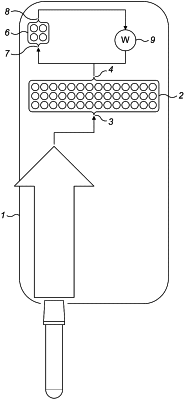| CPC B01L 3/502761 (2013.01) [G01N 33/56966 (2013.01); B01L 2200/0631 (2013.01); B01L 2200/0668 (2013.01); B01L 2300/0645 (2013.01); B01L 2300/0816 (2013.01); B01L 2300/0864 (2013.01); B01L 2300/0867 (2013.01); B01L 2400/0424 (2013.01)] | 15 Claims |

|
1. A microfluidic device for concentrating target cells, the microfluidic device comprising:
a first capture area through which a sample can be flowed, the first capture area comprising a plurality of electrodes tuned to trap the target cells using di-electrophoresis (DEP) when activated, and to release the target cells when de-activated, the electrodes arranged such that a sample flowing through the area will flow over them;
a waste area downstream of the first capture area and in fluid communication with the first capture area;
a second capture area downstream of the first capture area and in fluid communication with the first area, the second capture area being of a smaller volume than the first capture area and comprising a plurality of electrodes tuned to trap target cells using di-electrophoresis (DEP), the electrodes arranged such that a sample flowing through the second area will flow over them; and
one or more flow regulators adapted to ensure that the volumetric flow rate of sample travelling through the second capture area is lower than the volumetric flow rate of sample travelling through the first capture area,
wherein the device is arranged such that, when the electrodes tuned to trap the target cells using di-electrophoresis (DEP) in the first capture area are activated, sample flows out from the first capture area to the waste area, and, when the electrodes tuned to trap the target cells using di-electrophoresis (DEP) in the first capture area are de-activated, sample flows out from the first capture area to the second capture area.
|
|
8. A method for concentrating target particles in a sample, the method comprising:
providing a microfluidic device comprising:
a first capture area through which a sample can be flowed, the first capture area comprising a plurality of electrodes tuned to trap the target cells using di-electrophoresis (DEP) when activated, and to release the target cells when de-activated, the electrodes arranged such that a sample flowing through the area will flow over them;
a waste area downstream of the first capture area and in fluid communication with the first capture area;
a second capture area downstream of the first capture area and in fluid communication with the first area, the second capture area being of a smaller volume than the first capture area and comprising a plurality of electrodes tuned to trap target cells using di-electrophoresis (DEP), the electrodes arranged such that a sample flowing through the second area will flow over them; and
one or more flow regulators adapted to ensure that the volumetric flow rate of sample travelling through the second capture area is lower than the volumetric flow rate of sample travelling through the first capture area;
introducing a sample into the first capture area;
flowing the sample through the first capture area at a first flow rate, with the first plurality of electrodes activated and arranged to trap target particles, and with the sample flow being directed out from the first capture area to the waste area;
de-activating the first plurality of electrodes and releasing trapped target particles from the first plurality of electrodes to provide an enriched sample;
directing the enriched sample from the first capture area to the second area; and
introducing the enriched sample to the second area and flowing the enriched sample through the second area at a second flow rate which is lower than the first flow rate, and with the second plurality of electrodes arranged and activated to trap target particles.
|